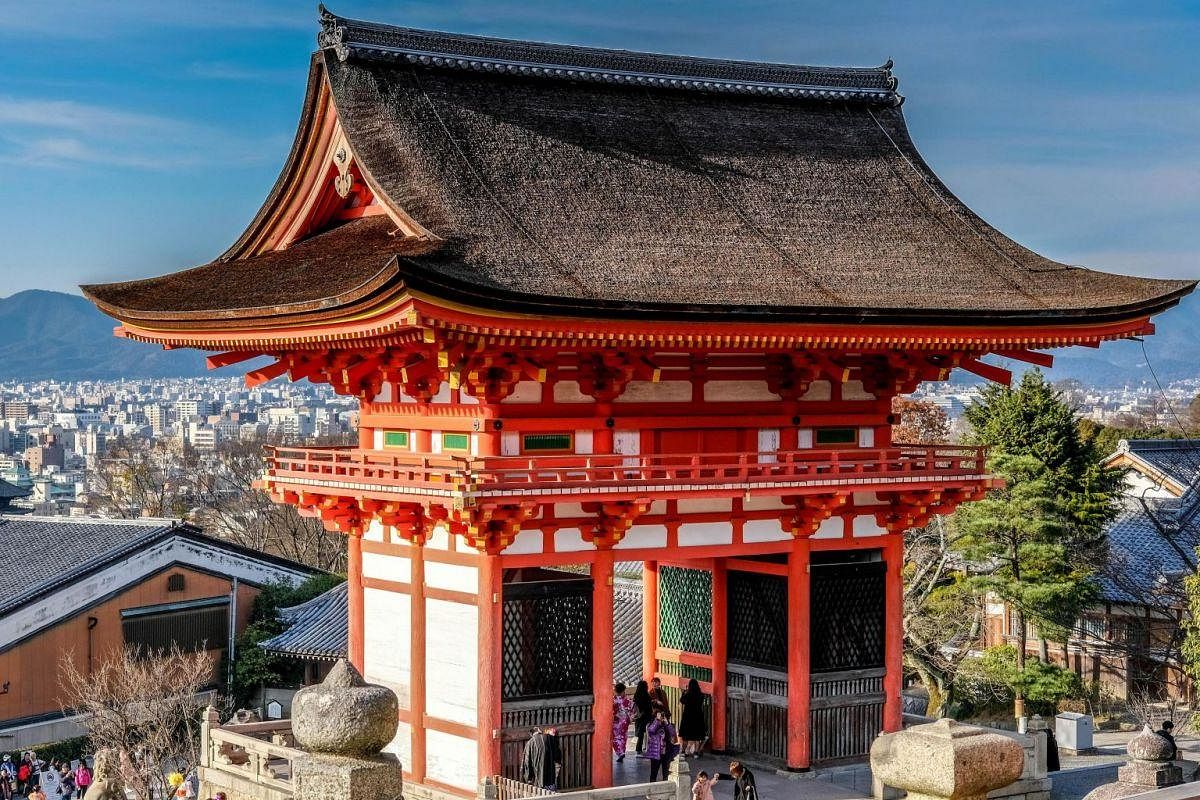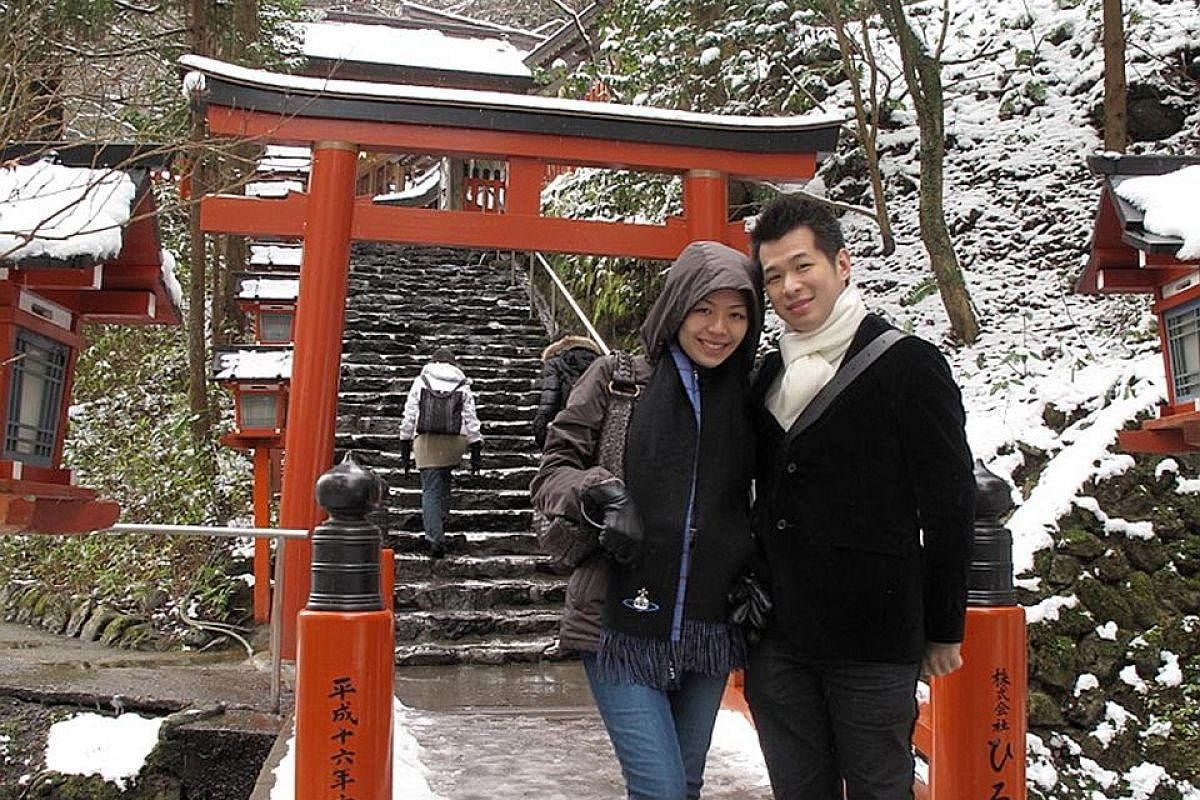-

WHO: Mr Gani Atmadiredja (right), 39, managing director of furniture and homeware retailer W. Atelier. The Indonesian managing director of furniture and homeware retailer W. Atelier has lived in Singapore for 13 years. He and his wife, Ms Katherine Halim, 31, have two daughters, Kelly, 4, and Alice, and 2. PHOTO: COURTESY OF GANI ATMADIREDJA
Travel Black Book CEO Series
Travel Black Book: Sights and smells of ancient Kyoto
Beautiful temples, well-preserved gardens and great food lure visitors to the Japanese city

PHOTO: WTS TRAVEL

WHO: Mr Gani Atmadiredja, 39, managing director of furniture and homeware retailer W. Atelier. The Indonesian managing director of furniture and homeware retailer W. Atelier has lived in Singapore for 13 years. He and his wife, Ms Katherine Halim, 31, have two daughters, Kelly, 4, and Alice, and 2.
Favourite destination: Kyoto, Japan. Many things make Japan special, but the very polite and accommodating Japanese people and variety of delicious food are a big part of why I love to return.
Kyoto is like a museum. It feels like some parts of the city have been preserved in time. I enjoy taking in the sights and smells of the ancient city, which has many beautiful and famous temple grounds.
I have been to Japan more than 20 times and it is also one of the few countries that are visa-friendly for Indonesians.
SEE
Kyoto is home to many beautiful temples and I recommend them to first-time visitors. Unfortunately, some such as Kiyomizudera Temple (www.kiyomizudera.or.jp), a Unesco World Heritage site, are major tourist attractions and the hordes of people with selfie sticks take some of the charm out of these beautiful places.
Past earthquakes have taken a toll on some of the buildings of the Kiyomizudera Temple and they have been undergoing major renovations for some time. But the temple is still worth visiting.
Another impressive and popular temple is the Tenryu-ji Temple (www.japan-guide.com/e/e3913.html) near the Arashiyama area. Another Unesco World Heritage site, it was built in 1339 and is home to the world-renowned Sogenchi Zen Garden.
One of my favourite sites is the Arashiyama Bamboo Grove (www.insidekyoto.com/arashiyama-bamboo-grove). It can be very packed so it is best to go in the early morning or late afternoon to avoid the crowds.
In Arashiyama, I recommend a small detour to Okochi Sanso Villa (www.japanvisitor.com/kyoto/okochi-sanso-villa), the former home of the famous silent movie actor Denjiro Okochi, a star from the 1920s until his death in 1962. With its beautiful gardens and hill-top view of Kyoto, it is a real hidden gem.
A short taxi ride from there takes you to Saihoji Temple (www.japan-guide.com/e/e3937.html), home to a serene moss garden with 120 varieties of moss. This is one of the few temples that require advance booking to limit the tourist crowd.
Head to Higashiyama District in the east of the city. This quaint, well-preserved historic area near the Kiyomizudera Temple with narrow lanes and traditional wooden townhouses takes you back in time to when Kyoto was the ancient capital city. You can spend hours there relaxing in cafes and people watching. It is also a good place to catch the sunset peeking behind the traditional buildings.
EAT
The language barrier can limit a visitor's ability to fully interact with the locals. But one way we learn about the culture is through the chefs and food because so much of Japanese culture revolves around and evolved with food.
One of my favourite restaurants in Kyoto is Keiraku Nikuryori Isshin (http://bit.ly/2DjDhI9), a beef speciality restaurant that uses Omi wagyu from the hometown of the restaurant's chef, Hideichi Katagiri. The two-Michelin-starred restaurant serves only a kaiseki meal with various cuts of beef taking centre stage in each dish. It is a must for beef lovers and the meal costs about $170 a person.
-
GETTING THERE
-

Singapore Airlines and Scoot fly directly to Osaka. From Osaka, take a bus, car or train to Kyoto, which is about an hour away by either mode of transport. If you are travelling to Kyoto directly from Osaka's Kansai International Airport, you can take the airport limousine bus, which costs 2,500 yen (S$30) a person.
TIPS
• I think the best time to visit Kyoto is in early April. With luck, you might catch the full bloom of the sakura season. Stay two to three nights so that you can explore the surrounding temples and hike the mountain paths.
• For restaurants, I think Tabelog (tabelog.com/en/kyoto/) provides the best crowd-sourced reviews and ratings in Japan.
• Aside from the unpredictability of natural disasters, Japan is a very safe place to visit.
Isshin is also near the Shirakawa canal, which is arguably the prettiest street in Kyoto.
If you don't want to splurge on food, go for one of the most fun dining experiences at Youshokuya Kichi Kichi (kichi2.net/), famous for serving the world's best omurice (an omelette on fried rice, 2,700 yen or S$32). Dinner will cost around $50 a person.
Keep in mind that most of the major restaurants open only from around 11am. If youwant an early morning breakfast, visit the old Nishiki Market (www.japan-guide.com/e/e3931.html), which is more than 400 years old and known as Kyoto's Kitchen. With hundreds of stalls packed into five narrow blocks, it is the perfect place to find some seriously delicious seasonal snacks, including grilled food on sticks, fishcakes and Kyoto's famous tsukemono.
Tsukemono are pickled vegetables that I think are an underrated part of Japanese cuisine and are made to perfection in Kyoto. Seasonal local produce is preserved by using simple yet precise ingredients to lock in their original flavours.
In Kyoto, the flavour and texture of tsukemono is enhanced, not overpowered, by the pickling process. You can find great tsukemono at the prominent Nishiri shop (sharing-kyoto.com/shop_Nishiri-Gion) in Gion main street. Prices range from about 300 to 1,000 yen a packet.
For lunch, head to nearby Gion Uokeya U (www.yagenbori.co.jp/tenpo/u/), about a 20-minute walk from Nishiki Market. This tiny restaurant is known for its generous servings of fresh, perfectly grilled unagi on a large bed of fluffy Japanese rice. Lunch costs around $50 a person and it is best to make a reservation.
Just two doors down is a quiet and charming hole-in-the-wall shop called Gion Kinana Honten (www.kyo-kinana.com/gionkinana), which serves Kyoto's most famous ice cream and matcha parfait.
PLAY
The Yasaka Theatre (www.kyoto-gioncorner.com) at the Gion Corner showcases seven types of Japanese traditional performing arts. Go there to watch a Kyo-mai dance, which is performed by geishas and maikos (apprentice geishas), as well as a visually stunning Bunraku puppet show. Despite the language barrier, you will immediately be captivated by how amazingly life-like the puppets can be.
The theatre also performs tea ceremonies, ikebana (flower arrangement), koto (ancient Japanese six-stringed zither) concerts, Gagaku (indigenous Japanese music and dance which were performed at the imperial court, shrines and temples) and Kyogen, a form of comedic theatre.
Kyoto is less than an hour's drive from Nara and Osaka. Nara is best known for its temples and Nara Park, where you can see wild deer.
Personally, I love Osaka. If you are into food, particularly street food, I suggest spending a few days in Osaka, a city for food lovers. They even have a word, kuidaore, which translates to "eating oneself into bankruptcy".
For first-time visitors to Osaka, I recommend eating your way through all the street food that Dotonbori, one of the city's main tourist destinations that runs along Dotonbori canal, has to offer.
In between meals, you can check out the seemingly endless shopping arcade that is Shinsaibashi-suji, a covered shopping street north of Dotonbori.
One of my favourite restaurants in Osaka is Wasabi (hozenji-wasabi.jp/en/).
This cosy hole-in-the-wall restaurant serves some of the best kushikatsu (fried skewers of meats and vegetables).
In a male-dominated Japanese restaurant industry, it is also refreshing to have a woman chef, Takako Imaki, helming the kitchen.
There is no menu. Chef Imaki will serve you skewer after skewer until your appetite is sated.
A stomach-stretching dinner there will set you back by around 10,000 yen, but it is well worth it.
SHOP
Kyoto is famous for many things, including Kiyomizu pottery, lacquer ware and Japanese knives, but personally, I go for the foodstuff.
My favourites are Japanese teas from Ippodo Teashop (www.ippodo-tea.co.jp/en/shop/kyoto.html).
Aside from the usual hojicha (charcoal roasted Japanese green tea), the smoky iribancha (made from the leaves, stems and small twigs from the lower portions of the tea plant which are roasted at a high heat) is a local favourite and costs about 800 yen for a 400g packet.
I always buy some tsukemono from the famous Nishiri shop in Gion main street and because I love spices, I also pick up some shichimi (Japanese spice mixture). The shichimi in Kyoto is milder in heat, but has complex flavours.
You can visit Shichimiya Honpo (www.shichimiya.co.jp), near Kiyomizudera Temple, for the normal shichimi or Hararyokaku (www.hararyoukaku.co.jp/shop/), located at Kyoto station, for the kuro (black) shichimi.
STAY
One of my most memorable stays was at a luxurious two-room ryokan at the foot of Kibuneyama mountain called Kifune Ugenta (www.tablethotels.com/en/kyoto-hotels/ugenta).
The maisonette suite is furnished with artisanal pieces from master woodworker George Nakashima, who was also an architect trained at the Massachusetts Institute of Technology.
On the mezzanine of the suite, you can enjoy a private outdoor onsen overlooking Kibuneyama.
Kifune Ugenta is along the banks of the famed Kibune River and the ryokan has constructed platforms over the river for visitors to enjoy the sights and sounds atop the flowing water while having a meal.
Join ST's Telegram channel and get the latest breaking news delivered to you.
A version of this article appeared in the print edition of The Sunday Times on December 24, 2017, with the headline Travel Black Book: Sights and smells of ancient Kyoto. Subscribe

